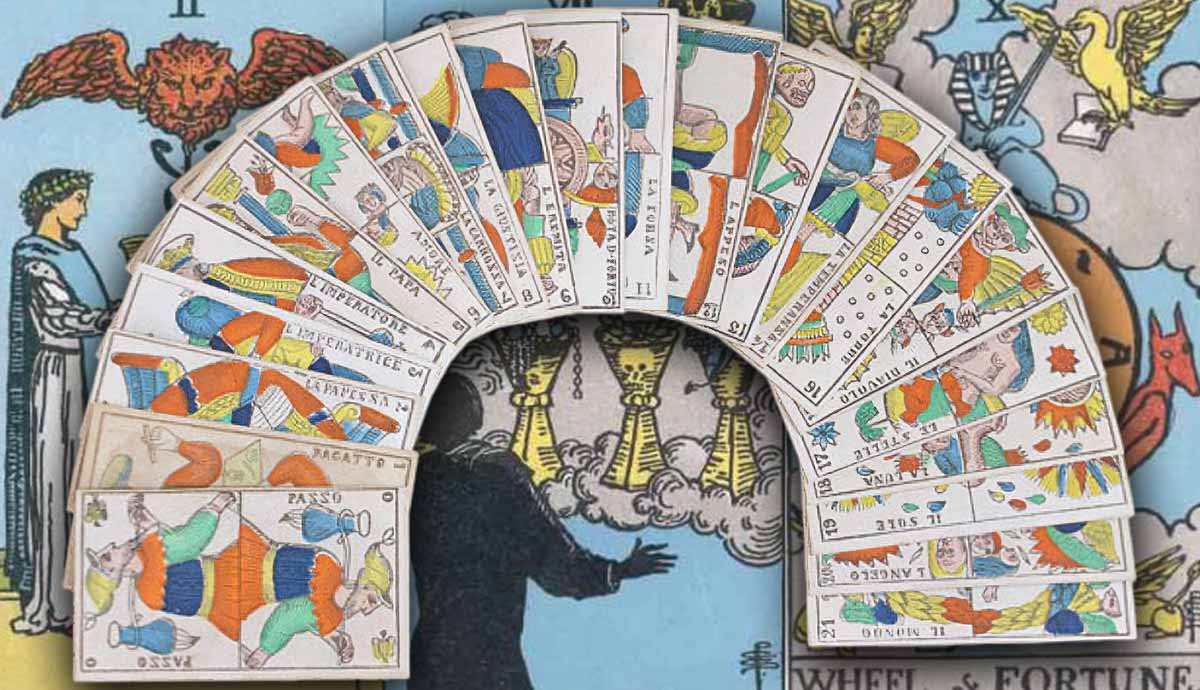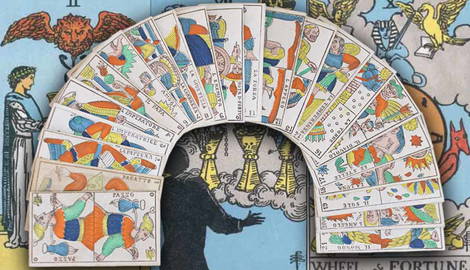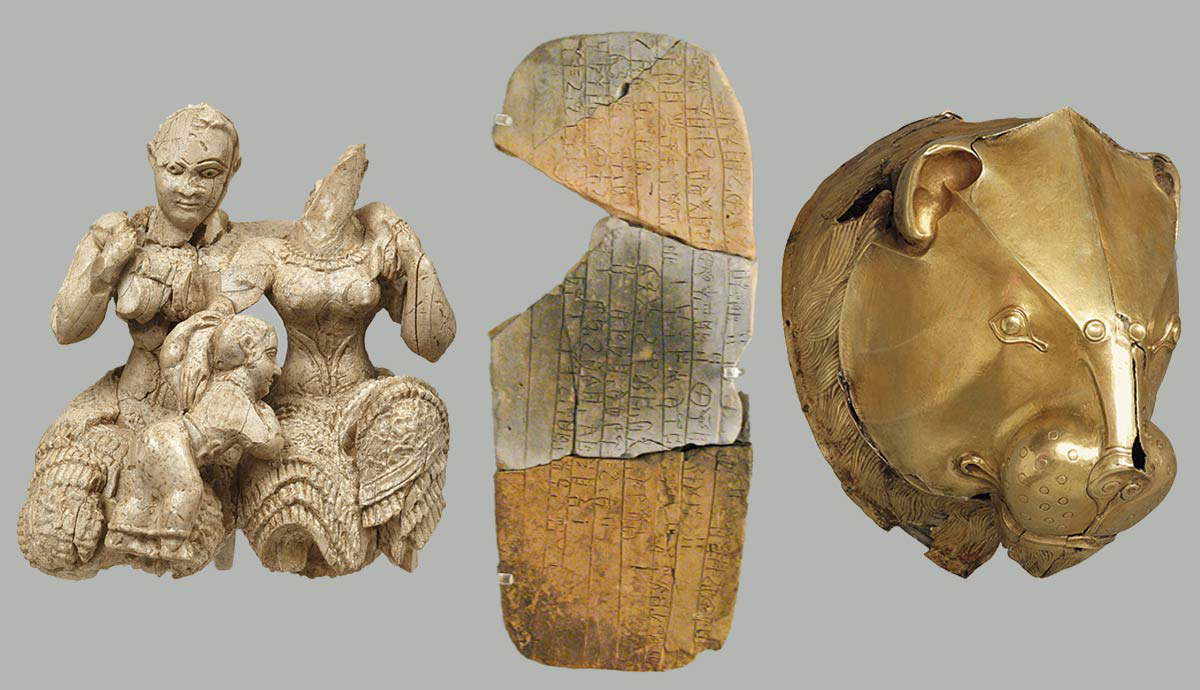
As you flip through a Tarot deck, you will see that each card features a detailed design. These designs use metaphors and cultural references to, in theory, represent all of life’s possibilities for the reader to interpret.
While tarot cards feature many design elements, among the most interesting when they appear are the mythological creatures. Dragon, sphinxes, and chimeras look out from the designs to help the reader interpret the secrets of the deck. But what are the cultural references behind these mythological creatures and how should their presence be interpreted in the Tarot?
Origins of the Tarot Design

Tarot cards are based on Malmuk playing cards that were brought to Europe in the 1300s by Islamic soldiers. They became popular in Italy, where they were used to play various games including Carte de Trionfe, which used the Major Arcana as trumps. For tarocchi appropriate, cards were laid out randomly and players made up stories about other players based on the cards dealt.
It was not long before the cards were redesigned by the Italians to incorporate Christian and European imagery. In particular, the Major Arcana cards were redesigned to reflect all the important aspects of daily life. Soon making up stories evolved into sortes, where a person’s destiny was read in the cards. The first treatise on Le Sorte was published in 1540, and by the 1700s, the Major Arcana had all been given set meanings.

The name Tarot emerged in the late 18th century when French occultists took an interest in it. They also developed the myth that the Tarot came from ancient Egyptian occult practices.
The cards were redesigned several times over the centuries, but the most popular modern design, known as the Rider-Waite deck, was principally developed by English occultist Arthur Waite with artist Pamela Colman and first printed in 1901. Importantly, before this time, the Minor Arcana looked more or less like a standard playing deck, and only the Major Arcana had elaborate designs. Waite and Coleman gave each card an esoteric design.
While there are many different Tarot deck designs available today, the majority are based on the symbology developed for the Rider-Waite deck. This means that the mythical creatures from Rider-Waite often appear in the same places within other decks. The mythology behind these creatures helps create the meanings of the cards they populate.
1. The Chimera on the Two of Cups

The term Chimera has come to be used for any animal that is a composite of other animals. But in the original Greek myth, the Chimera is a monstrous, fire-breathing lion with the head of a goat growing out of its back and a snake for a tail.
The Chimera was female and wreaked havoc on the realm of King Lobates of Lycia. She was the daughter of Typhon, a monstrous serpent giant, and Echidna, a half-woman half-snake monster. She was eventually defeated by the hero Bellerophon. The King of Lycia sent the young hero to kill the Chimera in the hope that she would kill him. But Bellerophon triumphed with the help of his winged horse Pegasus.
The Chimera appears on the Two of Cups but is a bit different from the Greek Chimera. It has the head of a lion and the tail of a snake, but the goat’s head is missing. Instead, it has wings.
In a Tarot reading, the Two of Cups represents that flow of love between two people and always references important connections and partnerships. The Chimera floats above a happy couple sharing a toast and it is a reminder that passion, chaos, and the unexpected are all part of a healthy relationship.
2. The Dragon on the Seven of Cups

While dragons appear in many cultures, considering the origins of Tarot designs, this one was probably inspired by Biblical dragons and European mythology. In the bible, the word dragon is often used in the Old Testament to refer to sea monsters, not unlike the Norse sea monster Jormungandr, who was also sometimes called a dragon. In the New Testament, the term dragon only appears in the book of Revelation, where it embodies the adversary of God.
In European mythology, dragons tend to wreak havoc on communities before they are destroyed by brave knights. They are also often associated with the hoarding of treasure. Since medieval Europeans believed that rulers had a responsibility to be generous with their wealth, the dragon was associated with the vice of avarice.
The dragon appears on the Seven of Cups, which shows a man standing before seven cups filled with various gifts. Some of the cups bear desirable gifts, such as jewels and a victory wreath, while others hold curses, such as serpents, and our dragon.
The presence of the dragon is a reminder to be careful what you wish for because not everything is as it seems. Even something that seems desirable or like a blessing can have a nasty sting. The card reminds the reader that while it is necessary to make choices, we shouldn’t be fooled by false promises.
3. The Jackal on The Wheel of Fortune

Jackals are dog-like animals that were known in Ancient Egypt to hang around graveyards at night. Therefore, in Egyptian mythology, they became associated with Anubis, one of the most important gods of the dead. He was a protector of graves, the god of embalming, and sometimes lord of the underworld, until he was replaced by Osiris.
Nevertheless, Anubis still ushered souls into the afterlife and participated in the ceremony that saw the dead person’s heart weighed against the feather of truth. This is why Anubis, as a jackal or a jackal-headed man, is one of the most depicted ancient Egyptian gods.
A humanoid jackal appears on the Wheel of Fortune card, which is one of the Major Arcana, alongside a few other fantastical creatures. The card shows a giant wheel, suggestive of the cyclical nature of life and the changing of fortunes. Anubis sits to the right of the wheel.
Death is an essential element in the cycle of life. In addition to representing physical death and return to the spirit, death also represents endings in the Tarot, and endings are always also beginnings.
4. The Sphinx on The Wheel of Fortune and The Chariot

The Sphinx also appears on the Wheel of Fortune card, as well as on The Chariot card, which is another Major Arcana card. The Sphinx is a mythical creature with the head of a human, the body of a lion, and sometimes wings. The most well-known Sphinx is the great statue at Giza but Sphinxes also appear in Egyptian and Greek mythology.
In both cases, Sphinxes were guardians. In Egypt, they were usually male (often with the head of the pharaoh) and seen as strong and benevolent. In Greece, they were very often female and challenged travelers to answer riddles to earn passage. If a traveler failed to answer correctly, they were eaten.
On the Wheel of Fortune Card, the Sphinx appears sitting on top of the wheel with a sword in hand. In this way, the Sphinx represents both the intelligence and strength that are required to climb to the top of the wheel.
On the Chariot card, two Sphinxes pull the chariot of a warrior. But the warrior holds no reigns, suggesting that he directs the Sphinxes with the power of his personality rather than force. The Sphinxes are depicted in opposing colors, suggesting that they represent duality and opposites. They also look as though they are pulling the chariot in different directions. In this way, they represent the forces in life that the charioteer must surf to find his direction.
5. Typhon on The Wheel of Fortune

Typhon also appears on the Wheel of Fortune card. While he just appears as a normal snake, his presence alongside the Sphinx and Jackal suggests that this must be the monstrous serpent from Greek mythology.
Typhon is the son of Titans and is said to be the son of Gaia, the personification of the earth, and Tartarus, the personification of the underworld. At one point, Typhon tried to overthrow Zeus himself and take control of the cosmos. The two were locked in a cataclysmic battle, which Zeus only just won with the help of his divine thunderbolts. When he was defeated, Typhon was thrown down to the underworld.
The battle with Typhon is included in Greek mythology mostly to explain how Zeus earned his position as the king of the gods. Typhon is also the progenitor of many of the other monsters in Greek mythology.
On the Wheel of Fortune card, Typhon appears on the left-hand side of the wheel. He is descending downwards from the heavens to the material world. This mimics Typhon’s descent from the heavens. In this way, Typhon’s presence can indicate that when we descend on the wheel of fortune, it is often a result of our own decisions and actions.
6. The Tetramorph on The Wheel of Fortune

The final mythological animals that appear in the Tarot also appear on the Wheel of Fortune card. There are three animals, an ox, an eagle, and a lion, that appear at the corner of each card along with an angel. The animals are given wings, making them fantastical, and this also indicates that the four corners should be read together as a Tetramorph.
A Tetramorph is the symbolic arrangement of four different elements into a single unit. It is a common symbol in Christianity meant to represent the four Evangelists: Matthew (angel), John (eagle), Mark (lion), and Luke (bull). They also represent the four fixed signs of the Zodiac: Aquarius (angel), Scorpio (eagle), Leo (lion), and Taurus (bull). The Tetramorph figures appear in the same positions on The World Tarot card but without wings. On the Wheel of Fortune Tarot card, the Tetramorphs represent the stability in the universe while our lives spin, often seemingly chaotically, around the Wheel of Fortune.










